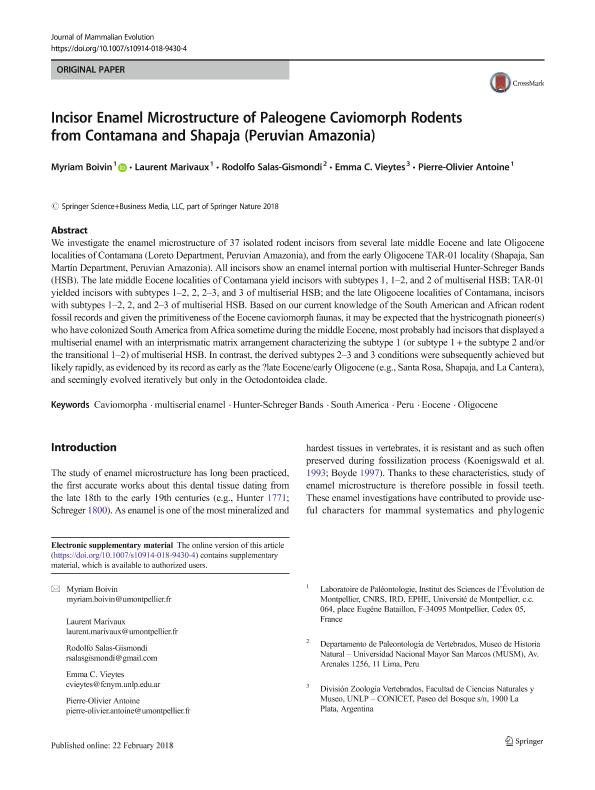Artículo
Incisor Enamel Microstructure of Paleogene Caviomorph Rodents from Contamana and Shapaja (Peruvian Amazonia)
Boivin, Myriam; Marivaux, Laurent; Salas Gismondi, Rodolfo; Vieytes, Emma Carolina ; Antoine, Pierre Olivier
; Antoine, Pierre Olivier
 ; Antoine, Pierre Olivier
; Antoine, Pierre Olivier
Fecha de publicación:
02/2018
Editorial:
Springer
Revista:
Journal of Mammalian Evolution
ISSN:
1064-7554
Idioma:
Inglés
Tipo de recurso:
Artículo publicado
Clasificación temática:
Resumen
We investigate the enamel microstructure of 37 isolated rodent incisors from several late middle Eocene and late Oligocene localities of Contamana (Loreto Department, Peruvian Amazonia), and from the early Oligocene TAR-01 locality (Shapaja, San Martín Department, Peruvian Amazonia). All incisors show an enamel internal portion with multiserial Hunter-Schreger Bands (HSB). The late middle Eocene localities of Contamana yield incisors with subtypes 1, 1–2, and 2 of multiserial HSB; TAR-01 yielded incisors with subtypes 1–2, 2, 2–3, and 3 of multiserial HSB; and the late Oligocene localities of Contamana, incisors with subtypes 1–2, 2, and 2–3 of multiserial HSB. Based on our current knowledge of the South American and African rodent fossil records and given the primitiveness of the Eocene caviomorph faunas, it may be expected that the hystricognath pioneer(s) who have colonized South America from Africa sometime during the middle Eocene, most probably had incisors that displayed a multiserial enamel with an interprismatic matrix arrangement characterizing the subtype 1 (or subtype 1 + the subtype 2 and/or the transitional 1–2) of multiserial HSB. In contrast, the derived subtypes 2–3 and 3 conditions were subsequently achieved but likely rapidly, as evidenced by its record as early as the late Eocene/early Oligocene (e.g., Santa Rosa, Shapaja, and La Cantera), and seemingly evolved iteratively but only in the Octodontoidea clade.
Archivos asociados
Licencia
Identificadores
Colecciones
Articulos(CCT - LA PLATA)
Articulos de CTRO.CIENTIFICO TECNOL.CONICET - LA PLATA
Articulos de CTRO.CIENTIFICO TECNOL.CONICET - LA PLATA
Citación
Boivin, Myriam; Marivaux, Laurent; Salas Gismondi, Rodolfo; Vieytes, Emma Carolina; Antoine, Pierre Olivier; Incisor Enamel Microstructure of Paleogene Caviomorph Rodents from Contamana and Shapaja (Peruvian Amazonia); Springer; Journal of Mammalian Evolution; 26; 3; 2-2018; 389-406
Compartir
Altmétricas



